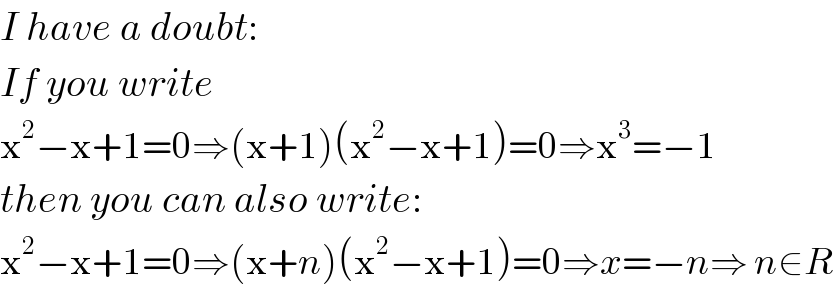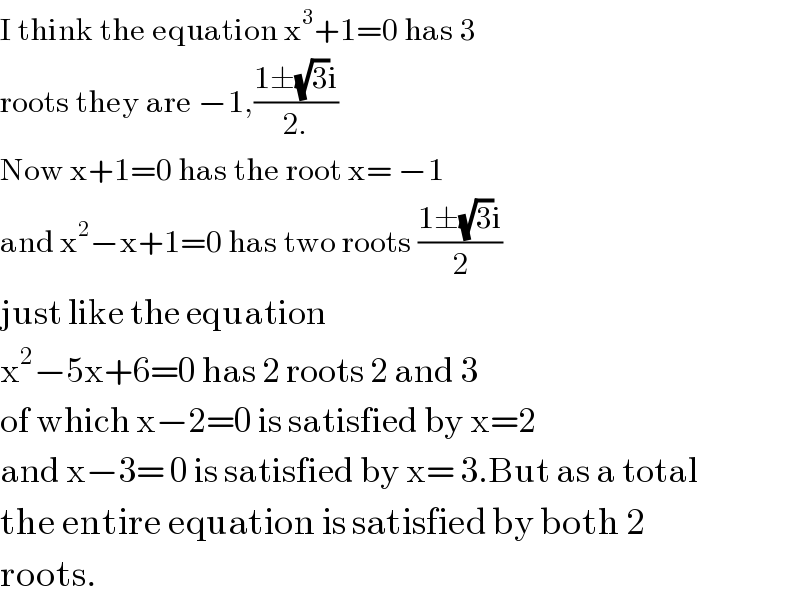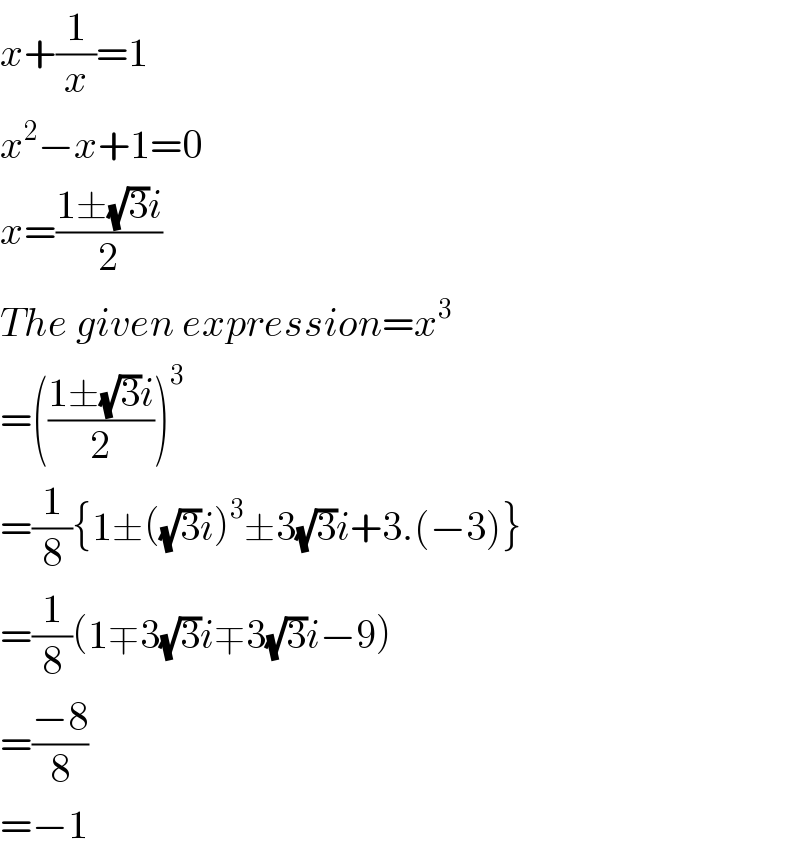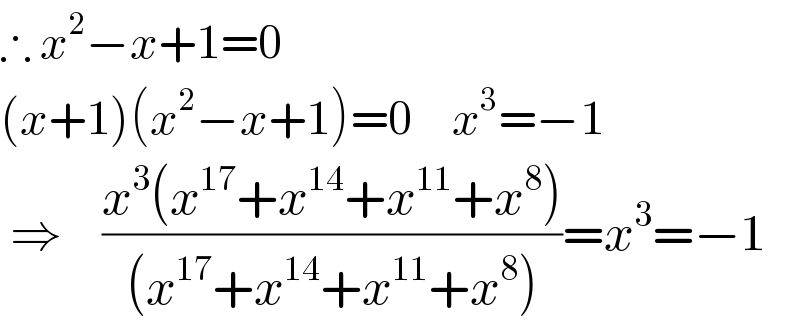Question Number 66058 by arvinddayama01@gmail.comm last updated on 08/Aug/19

$${If}\:\:\:\:{x}\:+\:\frac{\mathrm{1}}{{x}}=\mathrm{1} \\ $$$$ \\ $$$${find}\:{out}\:{value}:− \\ $$$$ \\ $$$$\:\:\:\:\frac{{x}^{\mathrm{20}} +{x}^{\mathrm{17}} +{x}^{\mathrm{14}} +{x}^{\mathrm{11}} }{{x}^{\mathrm{17}} +{x}^{\mathrm{14}} +{x}^{\mathrm{11}} +{x}^{\mathrm{8}} }\:\:\:\:=\:\:\:\:? \\ $$
Commented by Prithwish sen last updated on 08/Aug/19

$$\mathrm{x}^{\mathrm{2}} −\mathrm{x}+\mathrm{1}=\mathrm{0}\Rightarrow\left(\mathrm{x}+\mathrm{1}\right)\left(\mathrm{x}^{\mathrm{2}} −\mathrm{x}+\mathrm{1}\right)=\mathrm{0}\Rightarrow\mathrm{x}^{\mathrm{3}} =−\mathrm{1} \\ $$$$\frac{\mathrm{x}^{\mathrm{3}} \left(\mathrm{x}^{\mathrm{17}} +\mathrm{x}^{\mathrm{14}} +\mathrm{x}^{\mathrm{11}} +\mathrm{x}^{\mathrm{8}} \right)}{\mathrm{x}^{\mathrm{17}} +\mathrm{x}^{\mathrm{14}} +\mathrm{x}^{\mathrm{11}} +\mathrm{x}^{\mathrm{8}} }\:=\:\mathrm{x}^{\mathrm{3}} \:=\:−\mathrm{1} \\ $$
Commented by $@ty@m123 last updated on 08/Aug/19

$${I}\:{have}\:{a}\:{doubt}: \\ $$$${If}\:{you}\:{write} \\ $$$$\mathrm{x}^{\mathrm{2}} −\mathrm{x}+\mathrm{1}=\mathrm{0}\Rightarrow\left(\mathrm{x}+\mathrm{1}\right)\left(\mathrm{x}^{\mathrm{2}} −\mathrm{x}+\mathrm{1}\right)=\mathrm{0}\Rightarrow\mathrm{x}^{\mathrm{3}} =−\mathrm{1} \\ $$$${then}\:{you}\:{can}\:{also}\:{write}: \\ $$$$\mathrm{x}^{\mathrm{2}} −\mathrm{x}+\mathrm{1}=\mathrm{0}\Rightarrow\left(\mathrm{x}+{n}\right)\left(\mathrm{x}^{\mathrm{2}} −\mathrm{x}+\mathrm{1}\right)=\mathrm{0}\Rightarrow{x}=−{n}\Rightarrow\:{n}\in{R} \\ $$
Commented by Prithwish sen last updated on 08/Aug/19

$$\mathrm{I}\:\mathrm{have}\:\mathrm{just}\:\mathrm{used}\:\mathrm{the}\:\mathrm{formula}\:\mathrm{of} \\ $$$$\mathrm{a}^{\mathrm{3}} +\mathrm{b}^{\mathrm{3}} =\left(\mathrm{a}+\mathrm{b}\right)\left(\mathrm{a}^{\mathrm{2}} −\mathrm{ab}+\mathrm{b}^{\mathrm{2}} \right)\:\mathrm{where}\:\mathrm{I}\:\mathrm{just}\: \\ $$$$\mathrm{put}\:\mathrm{a}=\mathrm{x}\:\mathrm{and}\:\mathrm{b}\:=\:\mathrm{1}. \\ $$
Commented by Prithwish sen last updated on 09/Aug/19

$$\mathrm{I}\:\mathrm{think}\:\mathrm{the}\:\mathrm{equation}\:\mathrm{x}^{\mathrm{3}} +\mathrm{1}=\mathrm{0}\:\mathrm{has}\:\mathrm{3}\: \\ $$$$\mathrm{roots}\:\mathrm{they}\:\mathrm{are}\:−\mathrm{1},\frac{\mathrm{1}\pm\sqrt{\mathrm{3}}\mathrm{i}}{\mathrm{2}.} \\ $$$$\mathrm{Now}\:\mathrm{x}+\mathrm{1}=\mathrm{0}\:\mathrm{has}\:\mathrm{the}\:\mathrm{root}\:\mathrm{x}=\:−\mathrm{1} \\ $$$$\mathrm{and}\:\mathrm{x}^{\mathrm{2}} −\mathrm{x}+\mathrm{1}=\mathrm{0}\:\mathrm{has}\:\mathrm{two}\:\mathrm{roots}\:\frac{\mathrm{1}\pm\sqrt{\mathrm{3}}\mathrm{i}}{\mathrm{2}} \\ $$$$\mathrm{just}\:\mathrm{like}\:\mathrm{the}\:\mathrm{equation}\: \\ $$$$\mathrm{x}^{\mathrm{2}} −\mathrm{5x}+\mathrm{6}=\mathrm{0}\:\mathrm{has}\:\mathrm{2}\:\mathrm{roots}\:\mathrm{2}\:\mathrm{and}\:\mathrm{3} \\ $$$$\mathrm{of}\:\mathrm{which}\:\mathrm{x}−\mathrm{2}=\mathrm{0}\:\mathrm{is}\:\mathrm{satisfied}\:\mathrm{by}\:\mathrm{x}=\mathrm{2} \\ $$$$\mathrm{and}\:\mathrm{x}−\mathrm{3}=\:\mathrm{0}\:\mathrm{is}\:\mathrm{satisfied}\:\mathrm{by}\:\mathrm{x}=\:\mathrm{3}.\mathrm{But}\:\mathrm{as}\:\mathrm{a}\:\mathrm{total} \\ $$$$\mathrm{the}\:\mathrm{entire}\:\mathrm{equation}\:\mathrm{is}\:\mathrm{satisfied}\:\mathrm{by}\:\mathrm{both}\:\mathrm{2}\: \\ $$$$\mathrm{roots}. \\ $$
Commented by $@ty@m123 last updated on 09/Aug/19

$${One}\:{more}\:{observation}: \\ $$$${The}\:{given}\:{expression}\neq{x}^{\mathrm{3}} \\ $$$${when}\:{x}=−\mathrm{1} \\ $$
Answered by $@ty@m123 last updated on 08/Aug/19

$${x}+\frac{\mathrm{1}}{{x}}=\mathrm{1} \\ $$$${x}^{\mathrm{2}} −{x}+\mathrm{1}=\mathrm{0} \\ $$$${x}=\frac{\mathrm{1}\pm\sqrt{\mathrm{3}}{i}}{\mathrm{2}} \\ $$$${The}\:{given}\:{expression}={x}^{\mathrm{3}} \\ $$$$=\left(\frac{\mathrm{1}\pm\sqrt{\mathrm{3}}{i}}{\mathrm{2}}\right)^{\mathrm{3}} \\ $$$$=\frac{\mathrm{1}}{\mathrm{8}}\left\{\mathrm{1}\pm\left(\sqrt{\mathrm{3}}{i}\right)^{\mathrm{3}} \pm\mathrm{3}\sqrt{\mathrm{3}}{i}+\mathrm{3}.\left(−\mathrm{3}\right)\right\} \\ $$$$=\frac{\mathrm{1}}{\mathrm{8}}\left(\mathrm{1}\mp\mathrm{3}\sqrt{\mathrm{3}}{i}\mp\mathrm{3}\sqrt{\mathrm{3}}{i}−\mathrm{9}\right) \\ $$$$=\frac{−\mathrm{8}}{\mathrm{8}} \\ $$$$=−\mathrm{1} \\ $$
Answered by afjyormathchamp@gmail.com last updated on 08/Aug/19

$$\therefore\:{x}^{\mathrm{2}} −{x}+\mathrm{1}=\mathrm{0} \\ $$$$\left({x}+\mathrm{1}\right)\left({x}^{\mathrm{2}} −{x}+\mathrm{1}\right)=\mathrm{0}\:\:\:\:\:{x}^{\mathrm{3}} =−\mathrm{1} \\ $$$$\:\Rightarrow\:\:\:\:\frac{{x}^{\mathrm{3}} \left({x}^{\mathrm{17}} +{x}^{\mathrm{14}} +{x}^{\mathrm{11}} +{x}^{\mathrm{8}} \right)}{\left({x}^{\mathrm{17}} +{x}^{\mathrm{14}} +{x}^{\mathrm{11}} +{x}^{\mathrm{8}} \right)}={x}^{\mathrm{3}} =−\mathrm{1} \\ $$
